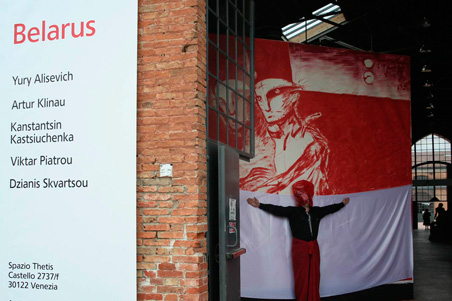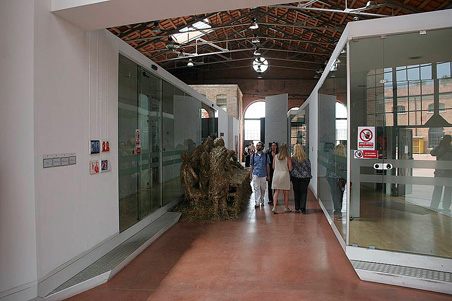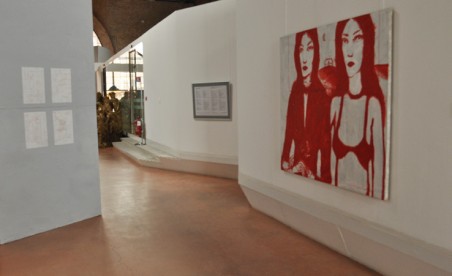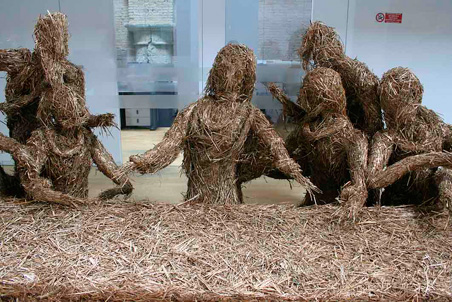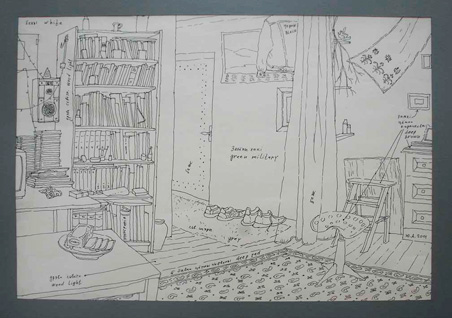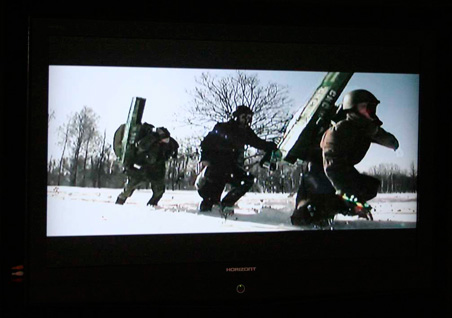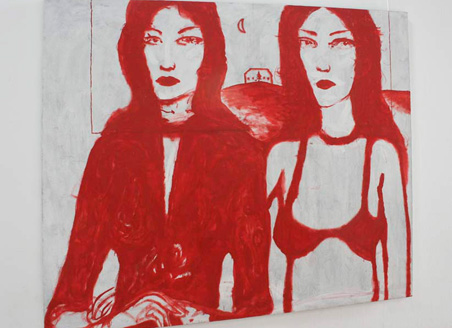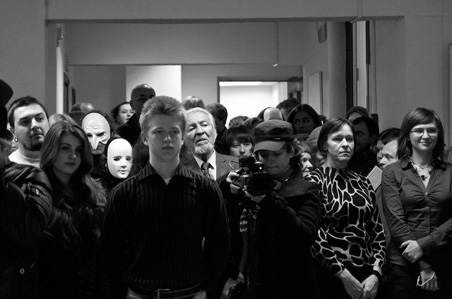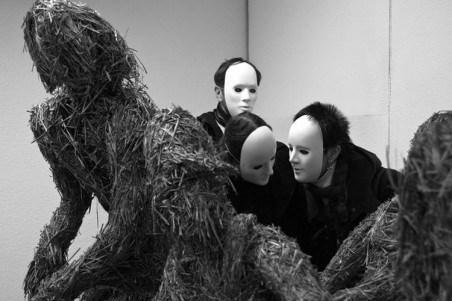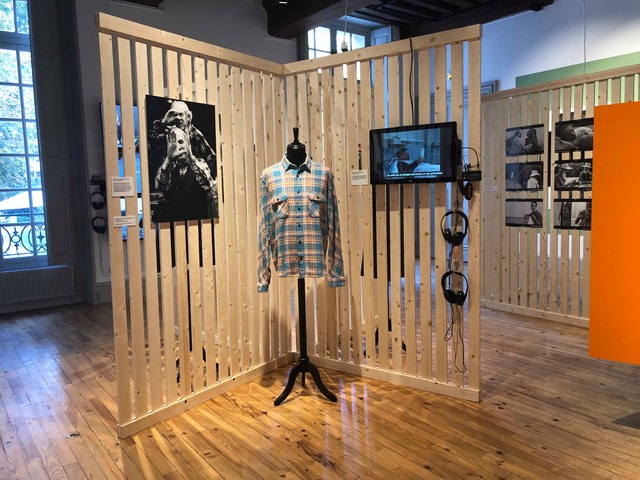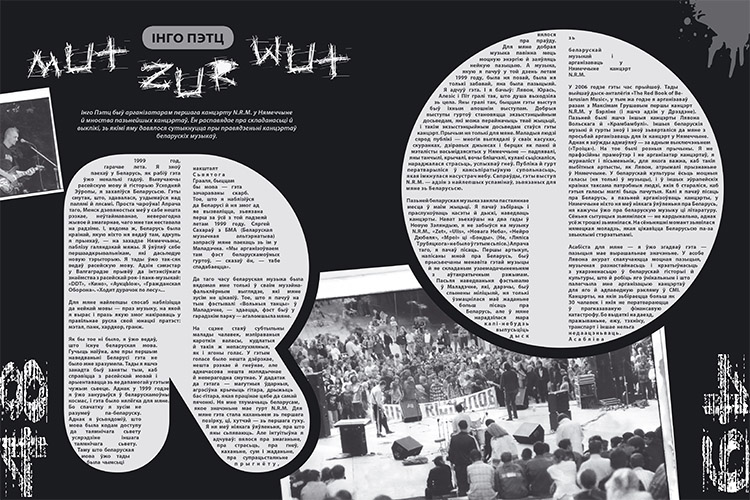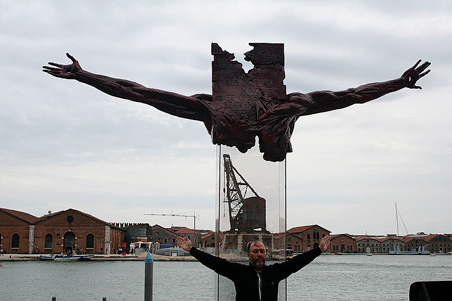
Belarusian Pavilion. Sculpture by Kanstancin Kasciućenka «Crucifix» \ During the performance of Viktar Piatrou
«From the beginning I was sure that the Belarusian Pavilion Venice Biennale, in addition to ‘winning’ state press correlations cause a lot of criticism from independent experts. But I would like to say to all the ‘oppressed’: do not worry! All will be there! Just let’s not trample this germ in the beginning. Let us calmly analyze what went wrong, and begin to prepare for the next Biennale».
These words artist and writer Artur Klinau said during an interview for a special Venetian 15th-issue of «pARTisan», released in 2011, almost as soon as Belarus took part in the oldest and most prestigious international art event — 54 Venice Biennale. Then curator of the Belarusian pavilion Michail Barazna, who was appointed by Belarusian Ministry of Culture, presented the project Kodex with the works by Jury Alisiević, Artur Klinau, Kanstancin Kasciućenka, Viktar Piatrou and Dzianis Skvarcou.
The results of this project were actively discussed and criticized by Belarusian independent art community. Nevertheless, it was clear that the first important step towards the integration of Belarusian contemporary art in a global context was done. Artists and curators were optimistic about the future.
But, unfortunately, when the next Biennale for Belarus will happen, it’s no longer clear. It is known that in 2013 at Venice Biennale in addition to the major permanent gamers − the countries of Western Europe, China, Russia and others − Bahamas, Bahrain, Ivory Coast, Kosovo, Kuwait, Maldives, Nigeria, Paraguay, and even Vatican will take part in the Biennale.
In other words, it will be whole map where Belarus, as usual, not found.
Does it mean that the official Belarusian Culture played long enough in Venice, or simply missed the deadline? We don’t know. We can only remember the last experience and publish the interviews of Artur Klinau, a participant of the Belarusian project in 54 Venice Biennale.
Archive! pARTisan #15’2011
Artur Klinau:
«Time to Change the Partisan Paradigm»
Qu: How did you take the news that Belarus would at last be represented at the Venetian biennale?
A: Positively, of course, for it should have happened a long time ago. As usual, our unique country chose to be the last to join in the all-important global event.
Qu: What makes it so important?
A: The Venetian biennale remains the world’s biggest communication field. Belarus until recently was non-existent in the global informational art field. Belarusian artists never took part in any major universal project. We live in an art ghetto. We are not represented at the Manifesto, or in Tokyo, or Istanbul, or Kassel, or even in Moscow. We are ignored not be¬cause Belarus lacks good authors. To change the situation, we must break the information blockade in the first place.
Qu: You think now that Belarus has been represented at the Venetian biennale, it will facilitate the breakthrough?
A: It certainly will, if we are going to be represented there on a permanent basis. We have only made the first step, so we should proceed without any illusions that everything would turn out fine at once. The universal contemporary art is guided by tough commercial laws. No one will give us a place under the sun on this market.
We will have to elbow our way into it, which is impossible for an artist alone.
He should be supported by national corporations, the media and cultural institutions. Another important thing about our participation in the biennale is that it is the first time the state, which ignored Belarusian contemporary art for ages, has de facto acknowledged it.
Qu: The state-owned media are speaking a lot about the Belarusian pavilion at the bien¬nale, but it is hardly mentioned in the foreign, particularly Russian press.
A: Locked in their post-imperial mentality, the Russians still do not see Belarus as an independent cultural phenomenon. They were reluctant to recognize Belarus as a political reality, but as a cultural project it is still viewed in Russia as ‘Russian culture of the north-west province.’ So take my advice, don’t read Russian papers before lunch.
Qu: What papers are there to read, then?
A: Italian ones. Italian reporters took interest in my project and said they admired it.
Qu: The Belarusian Ministry of Culture had promised that the preparation to the biennale would be open to the public and there would be a call for applications to select a curator’s project on a competitive basis. In reality, however, it was the other way round, though this kind of closeness in our context is not surprising…
A: I know the organizers of the pavilion are being strongly criticized. But there has to be an understanding that a national pavilion is invariably a curator’s project and the curator is the only one to choose artists to be represented in it. So any kind of competition is possible only at the stage of selecting the curator. I do agree the competition is necessary and I hope there is a call for curators’ applications next time.
Qu: Your participation in the project brought forth divided opinions. Some people were happy, as your straw definitely has all-important meaning and subtext in today’s world. Others were surprised, as the project was sponsored by the formal governmental institutions. On the Internet, you were even accused of collaboration with the regime…
A: Let us differentiate between political and cultural projects. Politicians on both sides of the divide are always eager to put a political label on any cultural project and use it for their own purposes. Yet, it is the Belarusian cultural project that has been the only one to enjoy sustainable development in recent years.
Moreover, I find the cultural project more important than the political one, since the former is a nation-building project.
It is impossible to have a thriving modern state as long as there is some mixture of post-Soviet and post-colonial mentality in our minds. When I hear accusations from people who saved their arses from the ‘atrocities of the regime’ by leaving Belarus a decade ago and are now teaching us, it makes me laugh. Today’s Belarus is not a black-and-white political comic. Our politicians are losers, who are squandering the state, whereas it is only culture that forms and reforms the nation, ensuring its survival in the future. It was a positive development in the context of this big cultural project that Belarus took part in the Venetian biennale. We represented Belarus rather than the present or future regime.
Qu: What was your contribution to the Belarusian pavilion?
A: It was a straw remake of The Last Supper by Leonardo, which turned out to be the right choice. When we arrived in Venice, I discovered that one of the biennale’s key motifs was The Last Supper by Tintoretto. I think my project fitted perfectly into the concept proposed by Bice Curigher, who was the curator of the Venetian biennale. My biggest disappointment, however, was the way in which my project was exhibited. The space was not suitable for such a project.
Qu: What kind of space was it?
A: The location was in an arsenal, which hosts about half of the national pavilions. But our hall was in fact a corridor, lined with glass offices on both sides. There was no place for sculpture at all. I had an idea that the composition might be hung high above, but it turned out impossible for technical reasons. I hope next time our organizers have enough money to rent some decent room.
Qu: What does a Belarusian artist feel when he finds himself in the general context of the biennale and sees other works and other pavilions?
A: The best pavilions rely on totally different funding and much more experience. To¬day Belarus has no problem with authors. I can name a few dozen artists who could represent Belarus at the Venetian biennale at the highest level. The problem is how to arrange and present the project properly.
Qu: What do you think are the prospects of contemporary Belarusian art? What path should we pursue, considering that we will never be able to catch up with western artists on the conceptual and technological level?
A: It may be a bold statement, but I totally disagree with it. Our contemporary artist has lived in the global information space long enough to feel all the concepts of the modern world. And there is no need to catch up with anyone technologically. True, our author cannot make a $100,000 worth installation packed with electronics, so what? Contemporary art is not a technological trick, since it employs ideas in the first place. ‘Straw’ can be enough to express an idea.
As for the development paths, the main thing is to change the partisan paradigm, ingrained in Belarusian authors. It is time to leave the underground.
Partisans’ time is running out. We no longer live on the occupied territory. It is our country..
Qu: That’s a bold statement, too! Perhaps you are going to change the name of the pARTisan magazine?
A: The Partisan is the mode of Belarusian mentality, individual survival and self-pres¬ervation. What we need today is a formula for joint action. However, we are not going the name of the magazine. After all, the Partisan is a key mythological construct of the Belarusians.
Qu: Are you happy about your participation in the 54th Venetian biennale?
A: I would be happier if my project had been exhibited differently. Of course, I could have said ‘no’ and decided to wait for better times, but a ‘bright tomorrow’ may never come. Furthermore, I have been less interested in contemporary art recently. In fact I am quite skeptical about it. At present I am getting more engaged in cinematography and literature, so maybe in a few years’ time I couldn’t take part in the Venetian bien¬nale at all just because of my ‘passivity’ in the field of contemporary art.
I knew that the Belarusian pavilion at the 54th Venetian biennale would cause not only ‘victorious’ reports in the state-run press, but also a lot of criticism by independent experts. So let us analyses rationally what went wrong and begin preparing for the next biennale.
Translated by Sviatłana Sous. Photos by Andrej Durejka. On the cover is a fragment of AdligaStudio work.
Views expressed are those of the authors and may not reflect opinion of the editors. If you note any error, please contact us right away.




